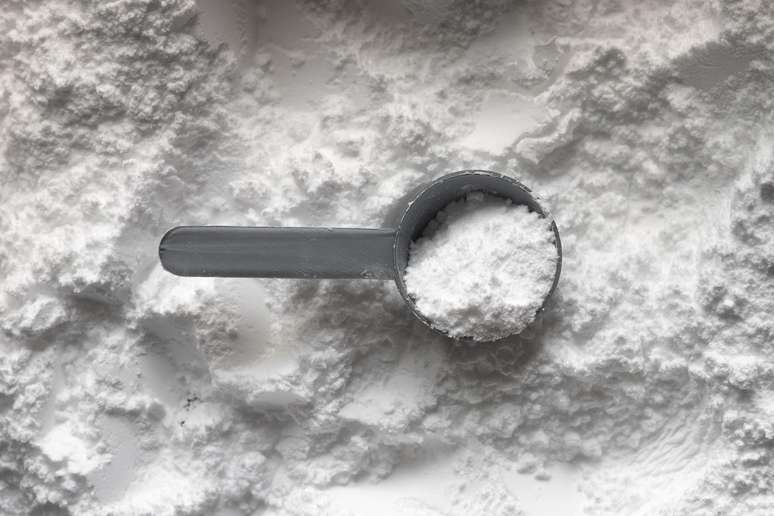Creatine, considered a very safe supplement, contributes to increasing muscle mass and sports performance.
While trends in the fitness world change frequently and some modalities, techniques and supplements quickly lose their appeal, creatine is one of the substances that remains firmly recommended by healthcare professionals thanks to its widely studied benefits.
Creatine is produced naturally by the human body through 3 amino acids (lysine, methionine, arginine) in the liver, kidneys and pancreas – and the substance also reaches our body through foods of animal origin, such as meat and milk.
Part of the substance is excreted in the urine and approximately 60-80% is stored in the body.
“When using creatine in supplemental form, these reserves are replenished, which helps improve performance and strength during exercise,” explains Felipe Henning Gaia Duarte, president of SBEM-SP (Brazilian Society of Endocrinology and Metabology – Regional of Sao Paulo).
What are the benefits of creatine?
Creatine improves the availability of the energy needed to maintain muscle contraction during strenuous physical activities.
This results in better physical performance, greater ability to perform resistance exercises, accelerated recovery between sets and contributes to the development of strength and muscle mass.
The primary function of creatine is its conversion to phosphocreatine in muscle fibers. Phosphocreatine acts as an immediate energy reserve, providing phosphate groups that play a key role in the rapid regeneration of ATP, the main source of energy in cellular activities.
“This increases the work capacity during intense exercises, allowing you to postpone fatigue, which translates into carrying out more repetitions of exercises or series with greater intensity, fundamental for acquiring muscle mass and strength”, describes Fabrício Buzatto, sports doctor and member of the SBMEE (Brazilian). Society of Exercise and Sports Medicine).
The supplement also improves recovery between sets, allowing you to train with greater intensity and frequency, which is essential for muscle growth.
The need to maintain a good amount of muscle mass is essential for health and well-being – and goes far beyond physical appearance and sports performance.
It helps control weight, prevent injuries, strengthen bones, regulate glucose levels and improve heart health. Furthermore, it contributes to healthy aging and promotes correct metabolic function [o equilíbrio saudável entre a energia que entra e sai, evitando problemas como obesidade ou desequilíbrios hormonais].
Creatine can also draw water into muscle cells, causing mild cell swelling. It’s important to note that this increase in water retention occurs within muscle cells, not adipose tissue, so creatine does not cause weight gain in the form of fat.
A study published in the scientific journal Medicine and science in sports and exercise have demonstrated the results of using creatine by comparing a group that received supplementation with another that received a placebo substance.
After a 12-week period, a significant increase in muscle mass and an increase in strength (measured by bench press, for the chest, and squat, for lower limb exercises) was observed.
Some studies also suggest that creatine may have benefits for brain function, helping to improve cognition in stressful situations, but there is no evidence to confirm its effectiveness in this specific application.

Who is creatine supplementation recommended for?
Some specific groups may benefit, such as high-performance athletes, people who need to gain muscle mass (including older adults), and those who follow specific diets. However, it is always necessary to consult a healthcare professional
Creatine monohydrate is the most common and effective form of supplement.
«Supplementation is particularly interesting for vegetarians and vegans, since creatine is found mainly in meat and foods of animal origin», underlines Buzzato.
Creatine is produced synthetically in laboratories. Substances such as sarcosinate and cyanamide undergo controlled chemical reactions that give rise to the creatine molecule.
After the chemical reactions, the final product is subjected to purification procedures, aimed at eliminating unwanted by-products. Finally, the purified creatine is converted into a dry powder through a drying process.
As for contraindications, the doctor states that creatine is generally safe, with some restrictions for patients with kidney failure.
“For those with liver problems, creatine can be used with caution, monitoring kidney and liver function and always under medical supervision.”
If the goal is to improve performance, doctors warn that creatine, without exercise, has no effect.
“Even for those diagnosed with osteopenia [perda gradual de massa óssea] and supplements with creatine, but does not exercise, creatine will have no role, neither in muscle mass nor in health”, underlines Duarte, president of SBEM-SP.
The same goes for those suffering from sarcopenia, the loss of skeletal muscle mass and strength.
In these cases, the main treatment would be physical activity to strengthen the body and a nutrient-rich diet; creatine would only be used as an extra aid in building muscle mass.
Regarding the dosage, Fabrício Buzzato underlines that the prescription can vary depending on the characteristics of each person, but is generally between 3 and 5 grams per day.
After the recommended intake, the format – capsules or powder – depends on each person’s choice. Capsules may be a more practical alternative, but their absorption is a little slower, as they must dissolve in the stomach before the contents are absorbed.
“It is not necessary to ingest too much and it is not necessary to use cycles, continuous use is recommended according to medical advice,” says the doctor.
There are experts who warn that excessive consumption, considered to be more than 30 grams per day, could cause liver and kidney dysfunction in the long term, as well as possible alterations in heart rhythm. However, scientific evidence on this aspect is scarce and does not provide a definitive conclusion.
Regarding product quality, Buzatto warns that it is essential to choose reliable brands and laboratories, with a good reputation and purity testing.
According to Anvisa regulations (National Health Surveillance Agency), a dose of the supplement must provide between 1.5 grams and 3 grams of creatine.
Why take creatine if it is produced naturally by the body?
Unlike some supplements, such as vitamin C, for which no supplementation is necessary for most people following a healthy diet, creatine is a special case.
“To get the recommended five grams of creatine, you should consume a large amount of meat [e ainda maior de outros alimentos, como leite]. The natural availability of creatine in nature is limited, which makes supplementation a sensible choice.”
According to Duarte, unlike other supplements, creatine has a continuous action, so there is no specific recommendation on consumption before or after training.
“The important thing is to take it together with foods that are sources of carbohydrates and proteins, because this way it will be retained better by the muscle.”
Source: Terra
Ben Stock is a lifestyle journalist and author at Gossipify. He writes about topics such as health, wellness, travel, food and home decor. He provides practical advice and inspiration to improve well-being, keeps readers up to date with latest lifestyle news and trends, known for his engaging writing style, in-depth analysis and unique perspectives.






![A Better Life Preview: What’s in store for Tuesday, October 21, 2025 Episode 446 [SPOILERS] A Better Life Preview: What’s in store for Tuesday, October 21, 2025 Episode 446 [SPOILERS]](https://fr.web.img6.acsta.net/img/fe/c7/fec79870332faf9ba9cf244248ec57c8.jpg)


